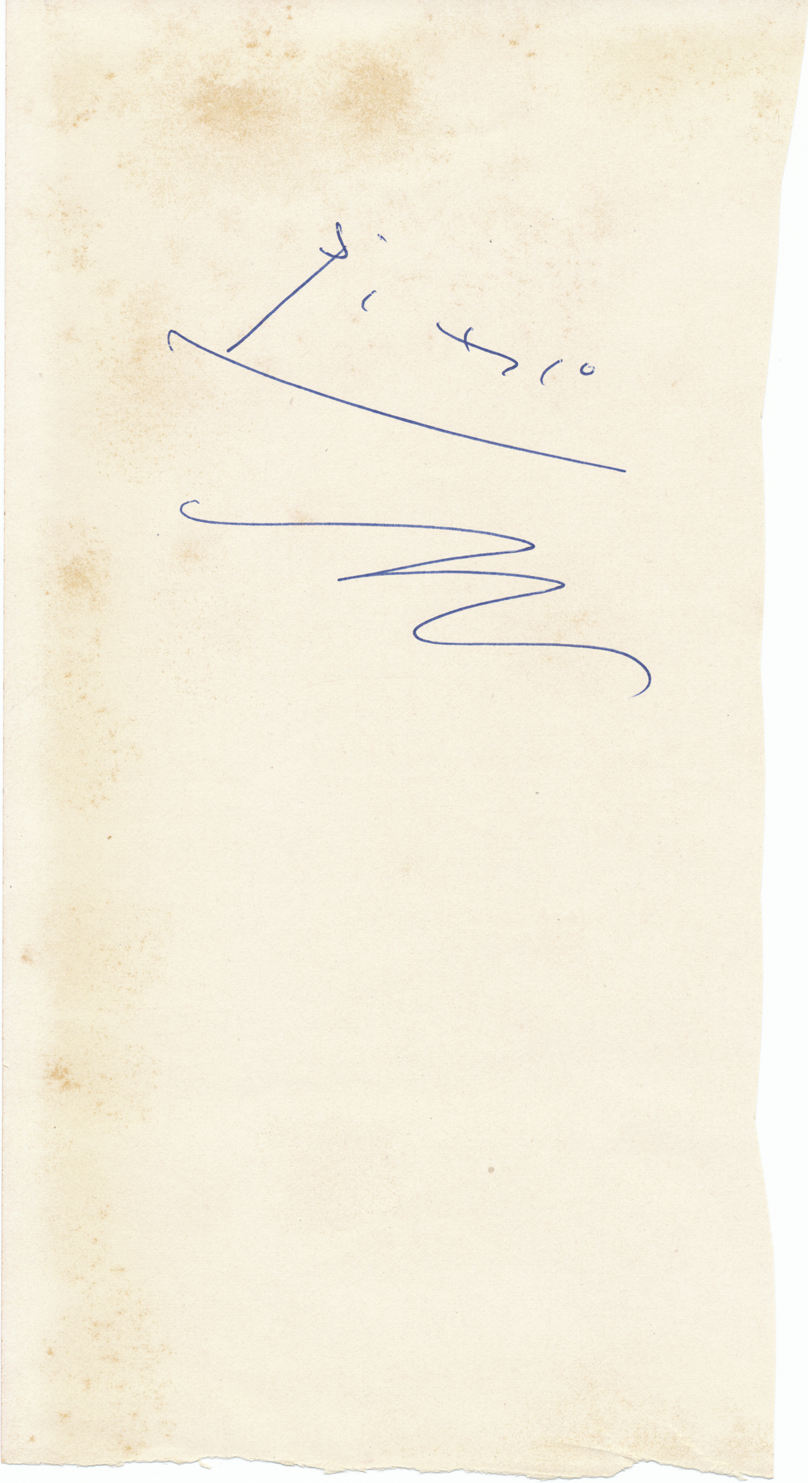Pablo Picasso
Pablo Picasso
Pablo Picasso Signature
Bold signature in blue ballpoint on 4″ x 7″ paper, likely removed from a book.
PABLO PICASSO (1881-1973), born Pablo Diego José Francisco de Paula Juan Nepomuceno María de los Remedios Cipriano de la Santísima Trinidad Martyr Patricio Clito Ruíz y Picasso, was an Andalusian-Spanish painter, draughtsman, and sculptor. As one of the most recognized figures in twentieth-century art, he is best known for co-founding the Cubist movement and for the wide variety of styles embodied in his work. Among his most famous works are the proto-Cubist Les Demoiselles d’Avignon (1907) and his depiction of the German bombing of Guernica during the Spanish Civil War, Guernica (1937).
After studying art in Madrid, Picasso made his first trip to Paris in 1900, then the art capital of Europe. There, he met his first Parisian friend, the journalist and poet Max Jacob, who helped Picasso learn the language and its literature. Soon they shared an apartment; Max slept at night while Picasso slept during the day and worked at night. These were times of severe poverty, cold, and desperation. Much of his work had to be burned to keep the small room warm. In Madrid in 1901, Picasso and his anarchist friend Francisco de Asís Soler founded the magazine Arte Joven (Young Art), which published five issues. Soler solicited articles and Picasso illustrated the journal, mostly contributing grim cartoons depicting and sympathizing with the state of the poor. From that day, he started to sign his work simply Picasso, while before he had signed Pablo Ruiz y Picasso.
In the early twentieth century, Picasso divided his time between Barcelona and Paris. In 1904, in the middle of a storm, he met Fernande Olivier, a Bohemian artist who became his mistress. Olivier appears in many of his Rose period paintings. After acquiring fame and some fortune, Picasso left Olivier for Marcelle Humbert, whom he called Eva. Picasso included declarations of his love for Eva in many Cubist works.
In Paris, Picasso entertained a distinguished coterie of friends in the Montmartre and Montparnasse quarters, including André Breton, poet Guillaume Apollinaire, writer Alfred Jarry, and Gertrude Stein. Apollinaire was arrested on suspicion of stealing the Mona Lisa from the Louvre in 1911. Apollonaire pointed to his friend Picasso, who was also brought in for questioning, but both were later exonerated.
Picasso’s work is often categorized into periods. While the names of many of his later periods are debated, the most commonly accepted periods in his work are the Blue Period (1901-1904), the Rose Period (1905-1907), the African-influenced Period (1908-1909), Analytic Cubism (1909-1912), and Synthetic Cubism (1912-1919).
At the time of his death many of his paintings were in his possession, as he had kept off the art market what he didn’t need to sell. In addition, Picasso had a considerable collection of the work of other famous artists, some his contemporaries, such as Henri Matisse, with whom he had exchanged works. Since Picasso left no will, his death duties (estate tax) to the French state were paid in the form of his works and others from his collection. These works form the core of the immense and representative collection of the Musée Picasso in Paris.
Several paintings by Picasso rank among the most expensive paintings in the world. Garçon à la pipe sold for $104 million at Sotheby’s on May 4, 2004, establishing a new price record. Dora Maar au Chat sold for $95.2 million at Sotheby’s on May 3, 2006.
As of 2004, Picasso had remained the top ranked artist (based on sales of his works at auctions) according to the Art Market Trends report.
All Vintage Memorabilia autographs are unconditionally guaranteed to be genuine. This guarantee applies to refund of the purchase price, and is without time limit to the original purchaser. A written and signed Guarantee to that effect accompanies each item we sell.

